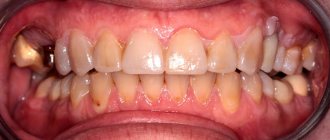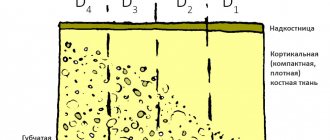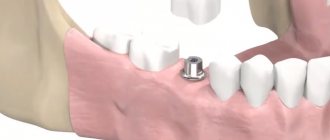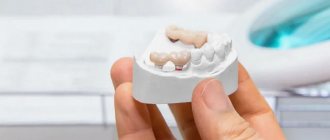The absence of two or more teeth in a row is fraught with the development of serious functional problems - disruption of the entire dental system and temporomandibular joints. Dental implantation is the most physiological way of replacing teeth. A titanium root completely replaces a natural tooth, taking over all its functions. The implantation option depends on the clinical features - the location and extent of the defect, the condition of the bone tissue.
- When used:
missing 2 teeth - Type of anesthesia:
local anesthesia - Procedure time:
from 30 minutes - Treatment period:
up to 4 months - Healing period:
up to 7 days - Age restrictions:
from 18 years old
Implantation methods in the absence of 2 teeth
Dental restoration is carried out using two protocols - two-stage (classical) with delayed loading or one-stage with immediate loading of a denture. It is also possible to install an implant in the socket of an extracted tooth.
Two-stage with delayed loading
- It is carried out in 2 stages - implantation and installation of an orthopedic structure are separated by a time interval of 2-6 months (implant healing time).
- Classic two-part implants are installed (the root part and the abutment are separate components).
- Implants are installed using the patchwork method - through an incision and peeling of the gums.
- After installation, the implant is closed with a plug and sutured until complete healing.
- After 2-6 months, the gum is cut again, a gum former is fixed to the implant, then an abutment and a permanent crown.
- During the engraftment of the implants, the defect is compensated with a removable immediate prosthesis Butterfly.
1
Implantation
Implantation of 2-3 implants
Installation of a butterfly prosthesis or temporary crowns (if it is possible to remove the bite)
4-6 months
2
Prosthetics
Installation of a permanent prosthesis
Classical implantation with simultaneous loading
A two-stage method in which the implant is almost immediately loaded with a prosthesis. In this case, the crowns are removed from the bite before the artificial roots engraft.
One-stage
- It is carried out in stage 1 - the orthopedic structure is installed on the implants immediately after their implantation (within 72 hours).
- Classic two-part implants are used (the abutment is screwed on immediately) or one-part implants (the artificial root and the abutment are a single structure).
- Implants are implanted using a minimally invasive method - through a micropuncture of the gums.
- Immediately after implantation of the artificial root or on the 2-3rd day, temporary crowns or an adaptive prosthesis are installed.
- After complete osseointegration of the implants, re-prosthetics with a permanent structure is performed (after 10-12 months).
Usually performed when two outer teeth are lost (for example, the 6th and 7th units in the absence of a number eight). In this case, 3 one-stage implants and 2 crowns are placed on them. In other situations, in the absence of only 2 teeth, it is not recommended to use the single-phase method.
One-stage after tooth extraction
- The artificial root is implanted non-surgically into the socket of the extracted tooth.
- Both one-piece and two-piece implants are used.
- Depending on the clinical situation, immediate or delayed loading of the prosthesis is possible.
The implantation method depends on the location and extent of the defect. When restoring the front row, if the situation allows, preference is given to single-stage protocols with immediate loading. The installation of two implants in the masticatory region is often carried out using the classic two-stage method with delayed prosthetics.
Temporary prosthesis
After 3 - 6 months, when the doctor is convinced that the implant is stabilized in the bone, a gum former is installed on it, since the gum line, due to the lack of a crown, may noticeably drop during this time. After two weeks, the former is removed, an abutment is installed and a temporary prosthesis is secured.
Implantation of two teeth side by side
Front teeth
When restoring the anterior group, any implantation method can be used. The doctor selects the treatment option depending on the initial situation. They use classic implants of small diameter and sufficient length, with aggressive threads (large at the bottom and small at the top) for atraumatic installation and stability in the bone. Basal, compression models are not used due to insufficient chewing load resources on the implanted artificial root.
When replacing 2 teeth in a row, 2 implants are implanted, each of which is covered with a crown immediately or after implantation. The method of prosthetics depends on in which zone of the frontal region the defect is localized. It is better not to load teeth in the risk zone (1, 2, 3) immediately, since the patient will bite off food with them, which will lead to displacement of the implant. In some situations, immediate loading is possible (at the patient's responsibility) with the removal of the crowns from the bite to preserve aesthetics.
Chewing teeth
When implanting the chewing zone, the treatment option is selected individually - it all depends on the indications, the number of missing teeth, and the condition of the jaw bone. Implants are placed in the lateral sections that can withstand increased chewing load. The method depends on the size of the defect:
- If there are no two teeth in a row, and the distance between them is small, replacing two units next to each other is carried out using the classical method - 2 titanium roots are implanted, each of which is covered with a crown. Since the posterior teeth are actively involved in chewing, immediate loading of crowns on classical implants is not carried out in order to avoid displacement of artificial roots. Until the implants are completely implanted, the dentition is filled with the Butterfly immediate prosthesis.
- If we are talking about replacing large teeth (6, 7) and a defect of a large extent, it is possible to install 3 one-piece implants (implanted at an angle, in areas with more suitable bone tissue in density and volume, bypassing the roots of adjacent teeth), which are covered with a bridge of 2 artificial crowns. Due to the design of one-stage implants fixed into the deep layers of the jaw, the installation of the prosthesis is carried out immediately. The orthopedic system acts as a splinting structure that combines the prosthesis and implants into a single system, stabilizes them in the bone and prevents them from loosening.
When implanting teeth that do not actively participate in the chewing process (4.5), immediate loading of even classical implants is possible - lightweight metal-plastic crowns are installed, removed from the bite (made a little smaller in height). At the patient’s request, it is possible to install crowns in the risk zone immediately, but in this case, the clinic does not provide a guarantee if the implantologist’s clear recommendations are not followed.
Alternative methods of prosthetics
To replace two lost teeth, 2 types of dentures are used. Removable consists of artificial gum with crowns and hooks that secure the dental structure to healthy teeth. The fixed bridge prosthesis is fixed to adjacent supporting units.
Disadvantages of methods:
- It is necessary to depulp and grind healthy dental crowns. This leads to the development of caries and other pathologies. Due to the high chewing load on the support, the roots become loose and become less stable.
- Atrophic processes continue in bone tissue.
- Difficult care, inconvenience, low aesthetics for removable models.
- Regular inflammation of the gums is possible due to food particles.
- Chewing function is not fully restored.
- Short-lived, require regular replacement.
Removable dentures and bridges have the lowest price, but are losing popularity every year. More and more patients are restoring their teeth with implants.
Is it possible to place one implant on two teeth?
To install a prosthetic structure, support is needed. Theoretically, the following options are possible:
- Installation of 1 implant and 2 crowns.
It means that one crown will be fixed on the implant, and the second will remain suspended. An unsupported prosthesis, when subjected to load, acts as a lever that will simply loosen and dislocate the implant from the bone.
- Installation of 1 implant and a bridge of 3 artificial crowns.
Supported by an implant and your own tooth. With this option, a depreciation effect occurs. A living tooth in the jawbone has mobility, an artificial root has maximum stability. The result of this difference is loosening and rejection of the implant.
In the absence of two adjacent dental units, it is better to choose two implants, each of which is covered with an artificial crown.
Implantation for isolated absence of 2 teeth
There are situations when a patient is missing one tooth in different parts of the jaw or on different jaws. If two teeth are missing at the same time, one upper left and the other lower right, 1 classic implant is installed with a delayed or immediate crown load. The type of implant structure used, the method of implanting an artificial root, and the timing of prosthetics depend on the area where the defect is located.
If a tooth is missing in an area with a high risk of displacement of the implant during chewing, prosthetics are performed after the artificial root has completely engrafted. In some cases - immediately, with the removal of the crown from the chewing process. This option is used when implanting anterior incisors to preserve aesthetics, but the patient must understand the possible risks.
If the missing teeth are on opposite sides, it is better to space out the implantation. After installing artificial roots, it will be necessary to limit chewing loads on the surgical area, so in order for the patient to retain the ability to chew food on at least one side, it is better to carry out implantation one at a time.
Choosing the optimal model
The rating of implants is determined taking into account the survival rate, service life, and the percentage of postoperative complications. The process of osseointegration is influenced by the professionalism of the doctor, the individual characteristics of the patient’s body and the ability of its tissues to recover. The qualifications of a dentist are very important, since even the installation of expensive implants can lead to complications if there is no real experience in their implantation.
Today, the following implantation systems are considered the most reliable: Straumann - high-quality Swiss-made implants with a lifetime guarantee. According to statistics, these products take root very well.
XIVE are German implants with exclusive threads that ensure reliable fixation. Can even be used with cancellous bone.
Nobel Biocare are expensive implants, available in a wide range, so you can choose the optimal solution for each situation. The products are characterized by rapid osseointegration and are equipped with double threads.
Astra Tech - high-quality developments by Swedish specialists, characterized by good stability.
In the manufacture of Anthogyr implants (France), high-quality titanium is used, due to which the products are highly resistant to external factors.
Is bone augmentation necessary?
One of the limitations to the installation of implants is the lack of bone tissue volume or its atrophy. It occurs as a result of a long toothless period, and bone loss begins almost immediately after the loss of a tooth by the root. The solution is to increase bone volume (osteoplasty in the lower jaw, sinus lift in the upper jaw) or protocols that allow implantation without bone grafting.
- With classical two-stage implantation, bone tissue augmentation in case of its deficiency is mandatory. For moderate and severe atrophy, osteoplasty is performed in a separate stage. Implants are installed after implantation of the osteoplastic material (after 2-3 months). If there is a slight loss of bone, replanting of osteoplastic material is possible simultaneously with the implantation of an artificial root.
- When installing one-stage implants, increasing bone volume in a separate stage is performed only in conditions of critical deficiency. In case of moderate atrophy - simultaneously with the installation of an artificial root; in case of slight recession, bone growth can be avoided by installing titanium roots at an angle in an area with sufficient volume and density of bone tissue.
One-stage protocols use implants that are attached to the cancellous bone and deeper basal layers that are not subject to atrophic processes.
Average prices in Moscow
| Name of service | Cost in rub. |
| Consultations | |
| Dentist | 600 |
| Periodontologist | 740 |
| Implantologist | 820 |
| Diagnostics | |
| X-ray of the tooth | 340 |
| Orthopantomogram | 1100 |
| Computed tomography (fragment of the dentition up to 3 teeth) | 2200 |
| Preparation period | |
| Professional hygiene with ultrasound | 2000 |
| Relief of periodontal inflammation | 2500 |
| Teeth brushing using the Air Flow method | 3500 |
| Treatment of caries | |
| Superficial | 2800 |
| Average | 3200 |
| Glubokoye | 3800 |
| Bone tissue augmentation | |
| Implantation of osteoinductive material in the area of 1 tooth | 10900 |
| Closed sinus lift | 17700 |
| Open sinus lift | 36700 |
| Implantation of two implants by manufacturer | |
| Alfa Bio (Israel) | 32000 |
| Osstem (Korea) | 40000 |
| "ROOTT" (Switzerland) | 50000 |
| MIS (Israel) | 50000 |
| Astra Tech (Sweden) | 86000 |
| Straumann (Switzerland) | 102000 |
| Nobel Biocare (Switzerland) | 120000 |
| Crowns for 2 implants | |
| Temporary | 18000 |
| Metal-ceramic | 40000 |
| From zirconium dioxide | 73200 |
Stages of treatment
1. Consultation
Examination, questioning, selection of treatment protocol.
2. Diagnostics and preparation
Comprehensive examination (orthopantomogram, CT), testing. Treatment of teeth and gums (if necessary), hygienic cleaning, 3D planning of surgery.
3. Implant installation
Carried out in accordance with the selected protocol. In a two-stage procedure, titanium roots are implanted using a patchwork method; in a one-stage procedure, titanium roots are implanted through a micropuncture of the gum or into the socket of an extracted tooth.
4. Prosthetics
Delayed loading with a prosthesis during classical implantation (a permanent orthopedic system is installed on artificial roots after they have completely engrafted). Immediate loading with a one-stage method (on days 1-3, adaptation crowns or a prosthesis made from the patient’s casts are installed on the abutments. After 10-12 months, re-prosthetics are performed with a permanent structure).
The one-step protocol includes one more stage - surgical removal of the affected tooth or root.
Preventive visits and professional oral hygiene
It’s not enough to simply restore teeth; you also need to take care of them so that teeth and implants serve without problems year after year. It is to monitor the condition of teeth and implants that you need to visit the dentist once every six months. To prevent gum inflammation, prevent dental caries and maintain healthy bone around implants, it is necessary to have professional plaque and tartar removal done at least once every 6 months. Read more about the “Teeth for Life” program developed by Dial-Dent specialists here.
How long does it take to install 2 implants?
| Classic method | One-step method | |
| Operation duration | 1-1.5 hours | 30-40 minutes |
| Healing time | 14-21 days | 5-7 days |
| Timing of prosthetics | Permanent crowns after complete osseointegration (after 2-6 months) | Adaptive prostheses for 1-3 days after implantation |
| Permanent prosthetics | 2-6 months | 6-12 months |
| Preliminary osteoplasty | 4-6 months | Simultaneously with implantation |










